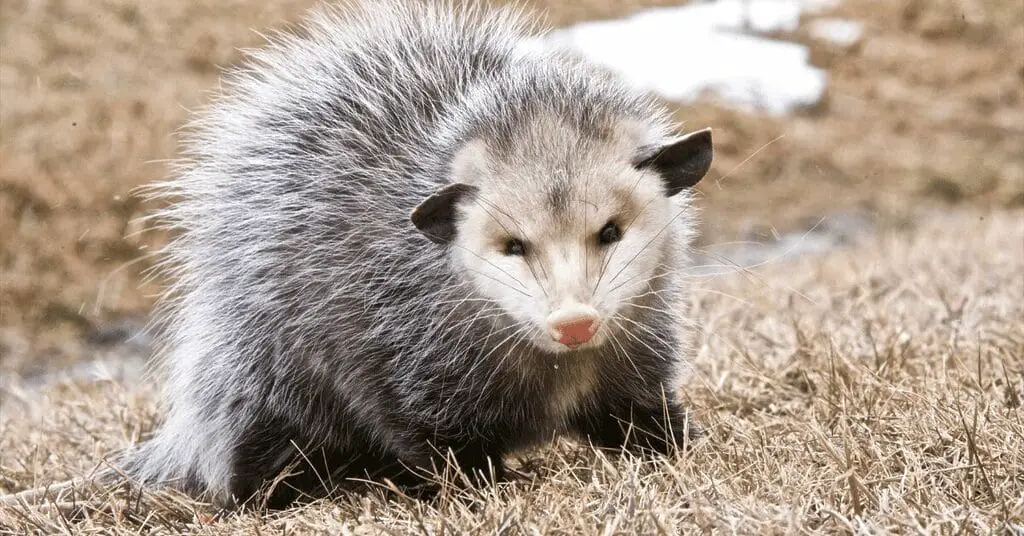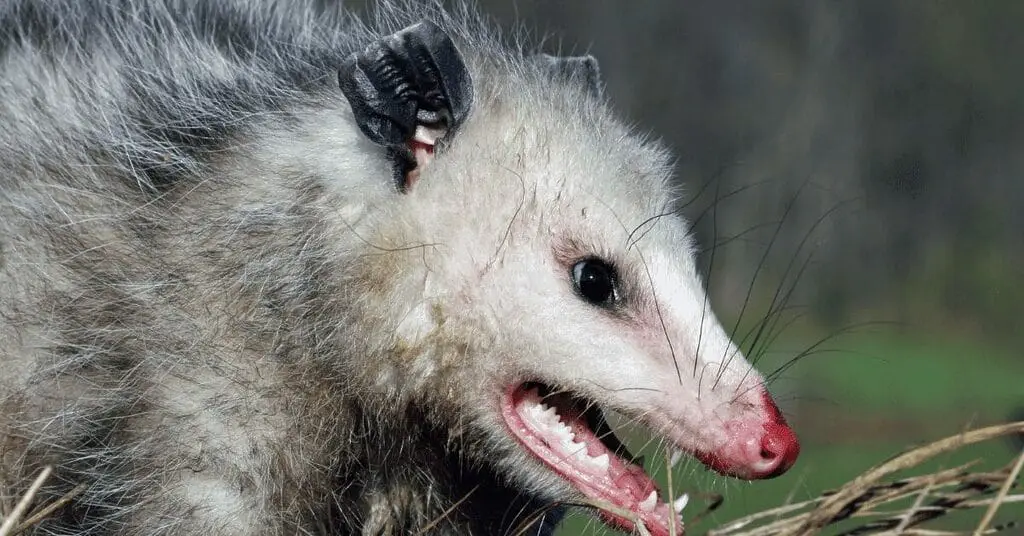Opossums, North America’s only marsupial, captivate with their unique biological traits, such as their famous ‘playing dead’ defense mechanism. However, their presence often raises questions and concerns, from their safety around humans to their mysterious nocturnal habits.
This post aims to explain these creatures, offering a gateway to comprehensive insights. Whether you’re concerned about potential health risks or simply curious about their lifestyle, we’re sure to shed light on these mysterious creatures.
We’re here to guide you through understanding these intriguing animals, transforming uncertainty into fascination. Explore the lesser-known facts about opossums in an engaging and enlightening journey.

Understanding Opossums
Opossums, often mistaken for rodents, are actually North America’s only native marsupials. These nocturnal animals are known for their distinctive trait of ‘playing dead’ as a defense mechanism.
Opossums typically inhabit wooded areas, though they are adaptable and can thrive in diverse environments, including urban settings. Their diet is omnivorous, encompassing fruits, insects, and small animals. For further details on this topic, explore: Are Opossums Rodents?
Delving deeper, opossums possess several unique features making them different from other mammals. They have prehensile tails used for grasping and balancing, and females have a pouch for carrying and nurturing their young.
Their adaptability to various habitats is remarkable, allowing them to survive in forests, farmlands, and even densely populated urban areas. Opossums play a crucial role in their ecosystems, notably in pest control, as their diet helps regulate insect and rodent populations.
Behavior and Habits
Transitioning from their basic characteristics, opossums show intriguing behaviors and habits, especially their climbing skills and unique approaches to colder seasons.
These animals are adept climbers, using their strong claws and prehensile tails to navigate trees with ease. This arboreal lifestyle helps them in foraging and escaping predators. For a detailed exploration of this aspect, read more at: Do Opossums Climb Trees?
However, contrary to common belief, opossums do not hibernate. Instead, they slow down during extreme cold but remain active.
They seek shelter in burrows, hollow logs, or even under buildings to stay warm. This behavior reflects their adaptability and resilience in varying climatic conditions. To understand more about their seasonal adaptations, visit: Do Opossums Hibernate?
Opossums’ nocturnal nature further defines their behavior. Primarily active at night, they search for food ranging from plants to small animals, showcasing their omnivorous diet.
Their solitary lifestyle, except during mating season, and their non-aggressive nature, often misconstrued as aloofness, are key elements of their behavior. Understanding these patterns provides insights into their survival strategies and the vital role they play in their ecosystems.
Physical Characteristics Of Opossums

Delving into the physical makeup of opossums, their unique dental structure and the presence of a pouch stand out as notable features.
Opossums have more teeth than any other North American mammal, totaling 50. This diverse dental structure equips them well for their omnivorous diet. For an in-depth look at their dental anatomy, check out: How Many Teeth Do Opossums Have?
Another unique trait is their marsupial pouch. Female opossums possess a pouch where their young, born at a very early stage of development, continue to grow and develop post-birth. This characteristic is crucial for their reproductive strategy and nurturing process. For more information about this fascinating aspect, visit: Do Opossums Have Pouches?
In addition to these characteristics, opossums have a variable fur color, usually grayish-white, and a long, hairless tail used for balance and grip. Their small, sharp claws aid in climbing, while their overall body size can vary significantly, with some growing as large as a domestic cat.
Understanding these physical characteristics enhances our comprehension of how opossums interact with their environment and survive in diverse habitats.
Opossums and Humans
Regarding the relationship between opossums and humans, several aspects emerge, including their potential as pets, safety concerns, and their interaction with poultry. While opossums are often spotted in backyards, their suitability as domestic pets is questionable due to their wild nature and specific care requirements.
keeping opossums as pets is illegal in many places. Additionally, even where legal, it’s generally not recommended. For a deeper understanding of this aspect, consider reading: Can Opossums be Pets?.
Safety is another critical topic. Generally, opossums are not aggressive towards humans and tend to avoid confrontations. However, like any wild animal, they can become defensive if threatened.
Their role in disease transmission is often overstated, but precautions should still be taken when in close proximity. For more on the safety aspects, visit: Are Opossums Dangerous?
In rural settings, concerns about opossums preying on poultry arise. While opossums are opportunistic feeders, their impact on chicken populations is typically minimal but not unheard of. To explore this relationship further, check out: Do Opossums Kill Chickens?
Understanding these interactions highlights the balance between cohabitation and conflict in human-opossum relationships. Awareness and informed perspectives can foster a harmonious existence with these intriguing creatures in our shared environments.
Health and Safety

Addressing health and safety concerns, it’s important to understand the risks associated with opossums, particularly regarding disease transmission and bite incidents.
While opossums are often misconceived as major disease carriers, their role in spreading diseases to humans is relatively limited. They are naturally resistant to some diseases, like rabies, but can carry other parasites and pathogens.
For detailed information on the diseases associated with opossums, refer to: Do Opossums Carry Diseases?
Regarding biting behavior, opossums are typically non-aggressive and prefer to avoid confrontation. Bites are rare and usually occur when they feel threatened or cornered.
It’s crucial to maintain a safe distance and not provoke these wild animals to minimize any risk of injury. For more insights into their biting behavior, explore: Do Opossums Bite?
Understanding these aspects of opossum health and safety can help mitigate unnecessary fears and promote informed interactions with these creatures. It’s essential for humans to recognize the natural behaviors of opossums and take appropriate measures to coexist safely with them in shared habitats.
Diet and Feeding
Exploring the diet and feeding habits of opossums reveals their adaptability and opportunistic nature. Opossums are omnivores, meaning they consume a varied diet including fruits, vegetables, insects, small animals, and even carrion.
This diverse diet reflects their ability to thrive in various environments, from natural woodlands to urban areas. To delve deeper into their dietary preferences, visit: What Do Opossums Eat?
Their foraging behavior is primarily nocturnal, taking advantage of their night vision and keen sense of smell. Opossums are scavengers, often searching for food in garbage cans, compost piles, or areas where food is readily available.
This behavior, while beneficial for the ecosystem in terms of cleaning up carrion and unwanted pests, can sometimes lead to conflicts in human-populated areas.
Understanding the dietary needs and foraging patterns of opossums not only enlightens us about their survival strategies but also assists in managing interactions with them, especially in urban settings. Awareness and respect for their feeding habits can help in creating a harmonious coexistence with these versatile creatures.
Encouraging Coexistence

Fostering a harmonious relationship between humans and opossums involves understanding and respecting their role in our ecosystems.
Encouraging coexistence can be beneficial, as opossums help control pests and clean up carrion. For those interested in attracting opossums in a safe and responsible manner, guidance can be found at: How to Attract Opossums
To attract opossums safely, consider providing natural food sources like fruits and vegetables in your garden. Ensuring a clutter-free yard that limits hiding spots can prevent unwanted nesting.
Installing nesting boxes can also provide a safe haven for opossums, encouraging them to stay away from areas where they might not be welcome. Importantly, avoid leaving pet food outside, as it attracts opossums and other wildlife, potentially leading to conflicts.
Understanding and implementing these tips can aid in peacefully coexisting with opossums. It’s about striking a balance – providing a safe environment for them while keeping human-opossum interactions positive and conflict-free. This approach benefits both our local ecosystems and the opossums themselves.
Conclusion
In summary, opossums, as North America’s only marsupial, present a unique blend of characteristics and behaviors. From their remarkable dental structure, including 50 teeth, to their adaptable feeding habits, these creatures are a fascinating study in survival and adaptability.
Their interactions with humans, while sometimes misunderstood, can be managed through informed practices, promoting a safe coexistence.
Understanding the nature of opossums – their diet, habitat preferences, and the myths surrounding their health risks – is crucial for appreciating their role in our ecosystems.
This comprehensive guide, spanning various aspects of opossum life, aims to enlighten and encourage a respectful relationship between humans and these intriguing animals. By embracing knowledge and empathy, we can appreciate the essential part opossums play in maintaining ecological balance.

